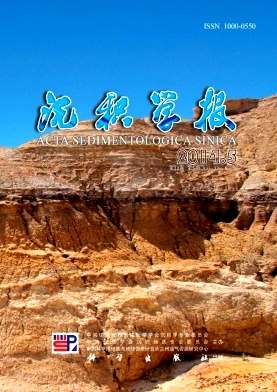|
[1]
|
Tucker B P, Wright V P. Carbonate Sedimentology[M]. Oxford: Blackwell Scientific Publications, 1990: 482-483 |
|
[2]
|
Moore C H. Carbonate Reservoirs-Porosity Evolution and Diagenesis in a Sequence Stratigraphic Framework[M]. Elsevier Science, 2001: 194-200 |
|
[3]
|
Wilson J L. Carbonate Facies in Geology History[M]. New York: Springer Verlag, 1975 |
|
[4]
|
陈景山, 李忠, 王振宇, 等. 塔里木盆地奥陶系碳酸盐岩古岩溶作用与储层分布[J]. 沉积学报, 2007, 25(6):858-868[Chen Jingshan, Li Zhong, Wang Zhenyu, et al. Paleokarstification and reservoir distribution of Ordovician carbonates in Tarim Basin[J]. Acta Sedimentologica Sinica, 2007, 25(6): 858-868] |
|
[5]
|
王振宇, 严威, 张云峰, 等. 塔中上奥陶统台缘礁滩体储层成岩演化及孔隙演化[J]. 新疆地质, 2007, 25(3):287-290[Wang Zhenyu, Yan Wei, Zhang Yunfeng, et al. Diagenesis and porosity evolution of upper Ordovician platform margin reefs and grain banks reservoir in Tazhong area[J]. Xinjiang Geology, 2007, 25(3): 287-290] |
|
[6]
|
张宝民, 刘静江. 中国岩溶储集层分类与特征及相关的理论问题[J]. 石油勘探与开发, 2009, 36(1):12-28[Zhang Baomin, Liu Jingjiang. Classification and characteristics of karst reservoirs in China and related theories[J]. Petroleum Exploration and Development, 2009, 36(1): 12-28] |
|
[7]
|
马永生, 储昭宏. 普光气田台地建造过程及其礁滩储层高精度层序地层学研究[J]. 石油与天然气地质, 2008, 29(5):548-556[Ma Yongsheng, Chu Zhaohong. Building-up process of carbonate platform and high-resolution sequence stratigraphy of reservoirs of reef and oolitic shoal facies in Puguang gas field[J]. Oil & Gas Geology, 2008, 29(5): 548-556] |
|
[8]
|
C&C Reservoirs. Hydrocarbon systems in carbonates[DB].Houston: C&C Reservoirs, 1998 |
|
[9]
|
马永生, 蔡勋育, 赵培荣. 深层、超深层碳酸盐岩油气储层形成机理研究综述[J]. 地学前缘, 2011, 18(4):181-192[Ma Yongsheng, Cai Xunyu, Zhao Peirong. The research status and advances in porosity evolution and diagenesis of deep carbonate reservoir[J]. Earth Science Frontiers, 2011, 18(4): 181-192] |
|
[10]
|
吴茂炳, 王毅, 郑孟林, 等. 塔中地区奥陶纪碳酸盐岩热液岩溶及其对储层的影响[J]. 中国科学(D辑):地球科学, 2007, 37(增刊Ⅰ):83-92[Wu Maobing, Wang Yi, Zheng Menglin, et al. Hydrothermal fluid karst and influences to reservoir in Ordovician carbonate rocks of Tazhong area[J]. Science China (Seri. D): Earth Sciences, 2007, 37(Suppl.Ⅰ): 83-92] |
|
[11]
|
Esteban M, Klappa C F. Subaerial exposure environment[C]//Scholle P A, Bebout D G, Moore C H. Carbonate Depositional Environments. AAPG Bulletin, 1983, 33: 1-54 |
|
[12]
|
Kerans C, Tinker S W. Carbonate sequence stratigraphy and reservoir characterization[C]. SEPM Short Course, 1997, 40: 155 |
|
[13]
|
郑和荣, 胡宗全, 周小进, 等. 中国前中生代海相储层发育的构造-沉积条件[J]. 石油与天然气地质, 2008, 29(5)574-581[Zheng Herong, Hu Zongquan, Zhou Xiaojin, et al. Tectonic and sedimentary conditions of pre-Mesozoic marine reservoirs in China[J]. Oil and Gas Geology, 2008, 29(5): 574-581] |
|
[14]
|
屈海洲, 王振宇, 杨海军, 等. 礁滩相碳酸盐岩岩溶作用及其对孔隙分布的控制——以塔中东部上奥陶统良里塔格组为例[J]. 石油勘探与开发, 2013, 40(5):552-558[Qu Haizhou, Wang Zhenyu, Yang Haijun, et al. Karstification of reef-bank facies carbonate rock and its control on pore distribution: A case study of Upper Ordovician Lianglitage Formation in eastern Tazhong area, Tarim Basin[J]. Petroleum Exploration and Development, 2013, 40(5): 552-558] |
|
[15]
|
陈景山, 王振宇, 代宗仰, 等. 塔中地区中上奥陶统台地边缘体系分析[J]. 古地理学报, 1999, 1(2):8-17[Chen Jingshan, Wang Zhenyu, Dai Zongyang, et al. Study of the Middle and Upper Ordovician rimmed carbonate platform system in the Tazhong area, Tarim Basin[J]. Journal of Paleaogeography, 1999, 1(2): 8-17] |
|
[16]
|
韩剑发, 孙崇浩, 于红枫, 等. 塔中Ⅰ号坡折带奥陶系礁滩复合体发育动力学及其控储机制[J]. 岩石学报, 2011, 27(3):845-856[Han Jianfa, Sun Chonghao, Yu Hongfeng, et al. Kinetics of reef-shoal complexes and its restriction to reservoir in Ordovician from Tazhong I fault belt[J]. Acta Petrologica Sinica, 2011, 27(3): 845-856] |
|
[17]
|
杨海军, 朱光有, 韩剑发, 等. 塔里木盆地塔中礁滩体大油气田成藏条件与成藏机制研究[J]. 岩石学报, 2011, 27(6):1865-1885[Yang Haijun, Zhu Guangyou, Han Jianfa, et al. Conditions and mechanism of hydrocarbon accumulation in large reef-bank karst oil/gas fields of Tazhong area, Tarim Basin[J]. Acta Petrologica Sinica, 2011, 27(6): 1865-1885] |
|
[18]
|
周新源, 王招明, 杨海军, 等. 中国海相油气田勘探实例之五——塔中奥陶系大型凝析气田的勘探和发现[J]. 海相油气地质, 2006, 11(1):45-51[Zhou Xinyuan, Wang Zhaoming, Yang Haijun, et al. Cases of discovery and exploration of marine fields in China (Part 5):Tazhong Ordovician condensate field in Tarim Basin[J]. Marine Origin Petroleum Geology, 2006, 11(1): 45-51] |
|
[19]
|
贾承造, 张师本, 吴绍祖, 等. 塔里木盆地及周边地层(上册)各纪地层总结[M]. 北京:科学出版社, 2003, 44-110[Jia Chengzao, Zhang Shiben, Wu Shaozu, et al. Stratigraphy of the Tarim Basin and Adjacent Areas[M]. Beijing: Science Press, 2003: 44-110] |
|
[20]
|
邬光辉, 李启明, 张宝收, 等. 塔中Ⅰ号断裂坡折带构造特征及勘探领域[J]. 石油学报, 2005, 26(1):27-30[Wu Guanghui, Li Qiming, Zhang Baoshou, et al. Structural characteristics and exploration fields of No.1 faulted slopebreak in Tazhong area[J]. Acta Petrolei Sinica, 2005, 26(1): 27-30] |
|
[21]
|
李本亮, 管树巍, 李传新, 等. 塔里木盆地塔中低凸起古构造演化与变性特征[J]. 地质论评, 2009, 55(4):521-530[Li Benliang, Guan Shuwei, Li Chuanxin, et al. Paleo-tectonic evolution and deformation features of the Lower Uplift in the Central Tarim Basin[J]. Geological Review, 2009, 55(4): 521-530] |
|
[22]
|
林畅松, 杨海军, 刘景彦, 等. 塔里木盆地古生代中央隆起带古构造地貌及其对沉积相发育分布的制约[J]. 中国科学(D辑):地球科学, 2009, 39(3):306-316[Lin Changsong, Yang Haijun, Liu Jingyan, et al. The characteristics of paleo-tectonic geomorphology and constraints of sedimentary facies distribution in Paleozoic tectonic, Central uplift, Tarim Basin[J]. Science China (Seri. D): Earth Sciences, 2009, 39 (3): 306-316] |
|
[23]
|
王振宇, 孙崇浩, 张云峰, 等. 塔中I号坡折带上奥陶统成礁背景分析[J]. 沉积学报, 2010, 28(3):525-533[Wang Zhenyu, Sun Chonghao, Zhang Yunfeng, et al. Analysis on the Upper Ordovician reef formation along the Tazhong SlopebreakⅠ[J]. Acta Sedimentologica Sinica, 2010, 28(3): 525-533] |
|
[24]
|
王振宇, 严威, 张云峰, 等. 塔中16-44井区上奥陶统台缘礁滩体沉积特征[J]. 新疆石油地质, 2007, 28(6):681-683[Wang Zhenyu, Yan Wei, Zhang Yunfeng, et al. Depositional characteristics of Upper Ordovician platform margin reefs in TZ16-44 aera, Tarim Basin[J]. Xinjiang Petroleum Geology, 2007, 28(6): 681-683] |
|
[25]
|
顾家裕, 张兴阳, 罗平, 等. 塔里木盆地奥陶系台地边缘生物礁、滩发育特征[J]. 石油与天然气地质, 2005, 26(3):277-283[Gu Jiayu, Zhang Xingyang, Luo Ping, et al. Development characteristics of organic reef-bank complex on Ordovician carbonate platform margin in Tarim Basin[J]. Oil & Gas Geology, 2005, 26(3): 277-283] |
|
[26]
|
王振宇, 孙崇浩, 杨海军, 等. 塔中Ⅰ号坡折带上奥陶统台缘礁滩复合体建造模式[J]. 地质学报, 2010, 84(4):546-552[Wang Zhenyu, Sun Chonghao, Yang Haijun, et al. Formation pattern of Upper Ordovician reef-bank complex along the Tazhong Slopebreak I, Tarim Block, NW China[J]. Acta Geologica Sinica, 2010, 84(4): 546-552] |
|
[27]
|
赵宗举, 陈轩, 潘懋, 等. 塔里木盆地塔中—巴楚地区上奥陶统良里塔格组米兰科维奇旋回性沉积记录研究[J]. 地质学报, 2010, 84(4):518-536[Zhao Zongju, Chen Xuan, Pan Mao, et al. Milankovitch Cycles in the Upper Ordovician Lianglitage Formation in the Tazhong-Bachu area, Tarim Basin[J]. Acta Geologica Sinica, 2010, 84(4): 518-536] |






 DownLoad:
DownLoad: